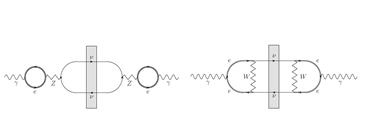Physicists propose new kind of quantum tunneling
Tunneling is the weird and wonderful process by which a quantum particle passes through a potential barrier that a classical particle could not traverse. It comes about because of the Heisenberg uncertainty principle which gives a finite probability for a quantum particle to cross a barrier of specific height and thickness.

In recent years, physicists have explored the possibility of a second type of tunneling which happens in an entirely different way. This relies on the idea that a quantum particle can change into another quantum particle and back again with a certain probability. The tunnelling occurs when the particle changes from one that interacts strongly with a barrier and so cannot pass though it, into a particle that does not interact with the barrier and so passes through with ease.
For example, quantum particles that change briefly into particles of dark matter should pass through barriers that should otherwise be impassable. This kind of “shining-a-light-through-a-wall” experiment is a serious contender in the search for dark matter.
Now Holger Gies from the Friedrich-Schiller-Universitat in Jena, Germany, and Joerg Jaeckel from Durham University in the UK, are proposing a third kind of tunnelling. In this case, a quantum particle changes into a pair of virtual particles which pass through the barrier and then change back again.
They give the example of photons changing into minicharged particles, particles with tiny fractional electronic charges which are predicted by some forms of string theory. These should pass through mirrors that would otherwise reflect photons, making it seem as if the photons had tunneled through the barrier (which in effect they had).
That’s an interesting and potentially important way of testing the predictions of string theory. And there aren’t too many of those around.
Ref: arxiv.org/abs/0904.0609: Tunneling of the 3rd kind
Keep Reading
Most Popular
Large language models can do jaw-dropping things. But nobody knows exactly why.
And that's a problem. Figuring it out is one of the biggest scientific puzzles of our time and a crucial step towards controlling more powerful future models.
How scientists traced a mysterious covid case back to six toilets
When wastewater surveillance turns into a hunt for a single infected individual, the ethics get tricky.
The problem with plug-in hybrids? Their drivers.
Plug-in hybrids are often sold as a transition to EVs, but new data from Europe shows we’re still underestimating the emissions they produce.
Stay connected
Get the latest updates from
MIT Technology Review
Discover special offers, top stories, upcoming events, and more.